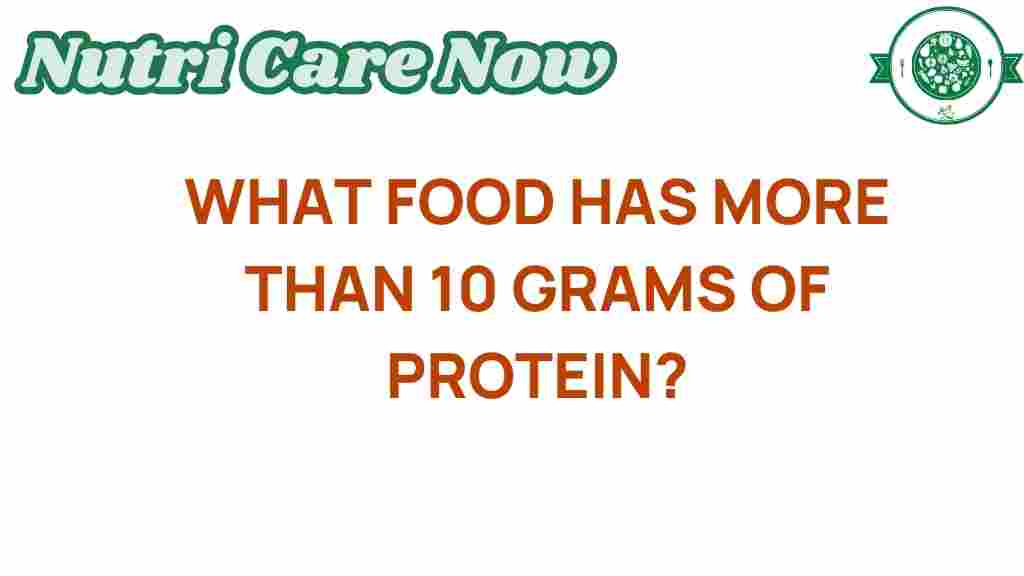Discover the Surprising Foods Packed with Over 10 Grams of Protein
When it comes to maintaining a healthy diet, protein-rich foods play a crucial role. They are essential for building and repairing tissues, producing enzymes and hormones, and are a vital component of every cell in our bodies. In this article, we will explore some surprising sources of protein that contain over 10 grams per serving. Whether you are a meat lover, a dairy enthusiast, or prefer plant-based options, there are plenty of choices available. Let’s dive into the world of nutrition and discover these powerhouse foods!
Why Protein is Important for Your Health
Protein is one of the three macronutrients—alongside carbohydrates and fats—that our bodies require in large amounts. Here are some reasons why you should prioritize protein-rich foods in your diet:
- Muscle Growth and Repair: Protein is vital for muscle health, especially for those who exercise regularly.
- Weight Management: High-protein foods can enhance feelings of fullness, reducing overall calorie intake.
- Bone Health: Adequate protein intake is linked to stronger bones and a reduced risk of osteoporosis.
- Hormone Production: Proteins are essential for the production of hormones that regulate various bodily functions.
Step-by-Step: Finding Protein-Rich Foods
To ensure you’re getting enough protein in your diet, focus on incorporating a variety of protein-rich foods. Here’s a step-by-step guide:
Step 1: Explore Meat Options
Meat is one of the richest sources of protein available. Here are some surprising options that pack over 10 grams of protein:
- Chicken Breast: A 3-ounce serving contains about 25 grams of protein.
- Ground Beef: A 3-ounce serving provides approximately 22 grams of protein.
- Pork Chops: A serving of 3 ounces contains around 23 grams of protein.
Step 2: Incorporate Dairy Products
Dairy products are another excellent source of protein. Consider adding these to your diet:
- Greek Yogurt: One cup has about 20 grams of protein.
- Cheese: An ounce of cheddar cheese offers around 7 grams, while cottage cheese can provide upwards of 14 grams per half-cup.
- Milk: One cup of cow’s milk contains about 8 grams of protein.
Step 3: Embrace Legumes
If you’re looking for plant-based options, legumes are fantastic sources of protein. Here are some legumes that contain over 10 grams of protein:
- Lentils: One cup cooked has about 18 grams of protein.
- Chickpeas: A cup cooked contains approximately 15 grams of protein.
- Black Beans: A cup cooked provides about 15 grams of protein.
Step 4: Discover Plant-Based Proteins
For those on a plant-based diet, there are numerous options available:
- Quinoa: One cup cooked has around 8 grams of protein, and it’s a complete protein source.
- Tofu: A half-cup serving provides about 20 grams of protein.
- Seitan: A meat substitute made from wheat gluten, containing approximately 25 grams of protein per 3 ounces.
Step 5: Snack Wisely
Snacking doesn’t have to mean sacrificing your protein intake. Here are some high-protein snacks:
- Protein Bars: Many bars are designed to deliver over 10 grams of protein per serving.
- Beef Jerky: A 1-ounce serving can provide around 10-15 grams of protein.
- Hummus with Veggies: Hummus made from chickpeas can offer 5 grams of protein per 2 tablespoons, so pair it with veggies for an added boost.
Troubleshooting: Common Issues with Protein Intake
As you explore protein-rich foods, you may encounter some challenges. Here are a few common issues and how to overcome them:
1. Too Much Meat
While meat is a great source of protein, consuming it in excess can lead to health issues. Try to balance your intake with plant-based proteins and dairy.
2. Vegetarian or Vegan Diets
If you follow a vegetarian or vegan diet, it can be challenging to meet protein needs. Focus on combining different plant-based sources, such as legumes, whole grains, and nuts, to ensure you get all essential amino acids.
3. Digestive Issues
Some individuals may experience digestive problems when consuming high-protein foods, particularly dairy. If you find this to be an issue, consider lactose-free options or plant-based alternatives.
Conclusion
Incorporating a variety of protein-rich foods into your diet is essential for maintaining optimal health. By exploring different categories such as meat, dairy, legumes, and plant-based options, you can easily meet your protein needs. Remember to balance your meals with other macronutrients and focus on whole foods for the best nutritional benefits.
For more information on how to create a balanced diet, check out this nutrition guide.
Embrace the power of protein today and enjoy the myriad of health benefits it brings to your life!
This article is in the category Diet and created by NutriCareNow Team
